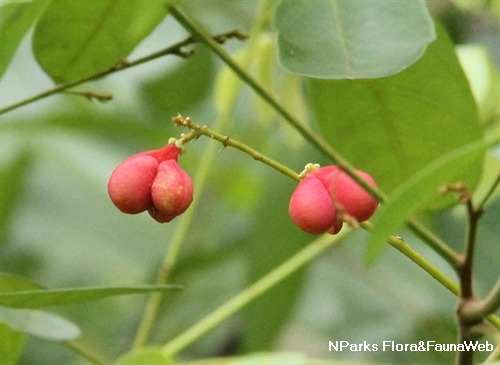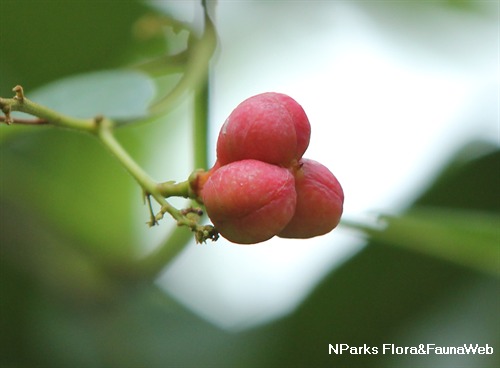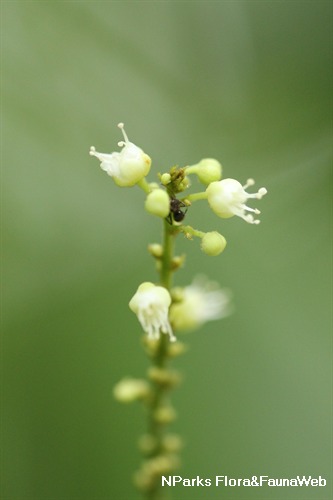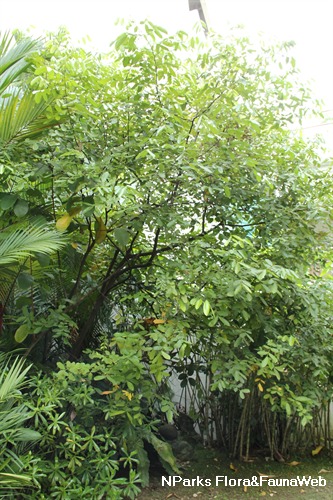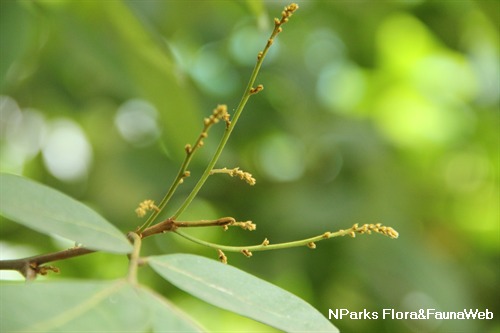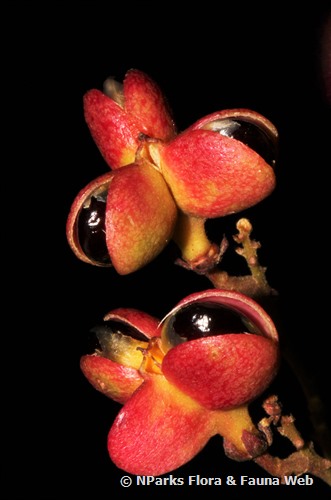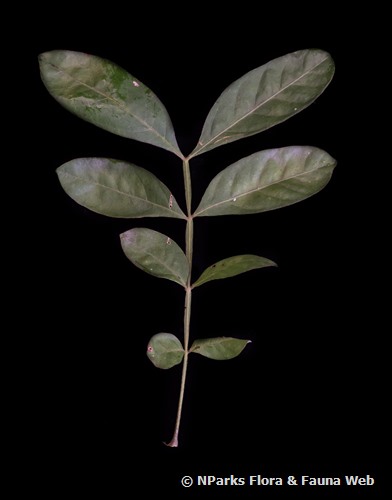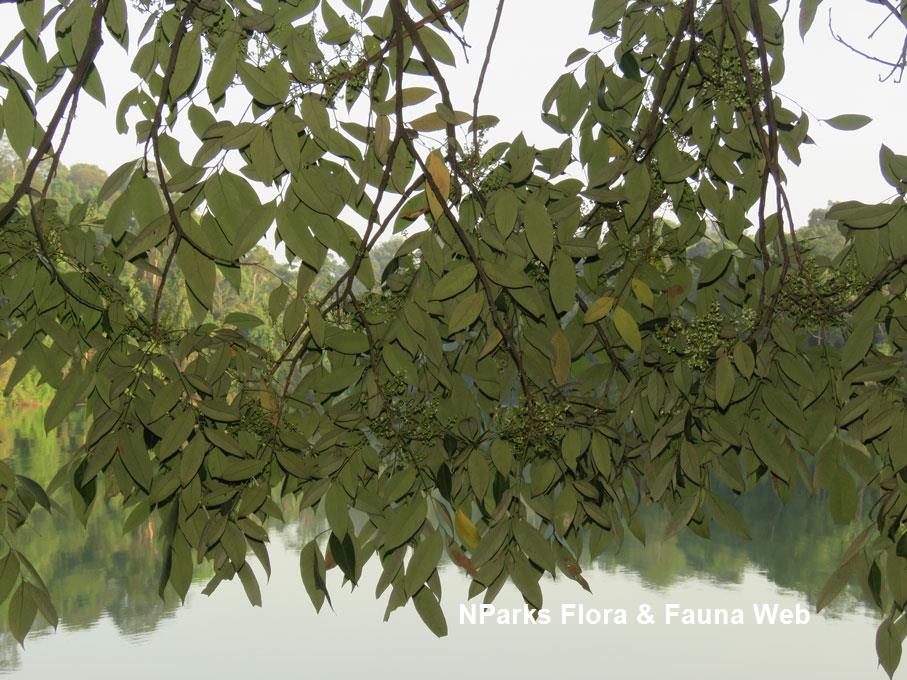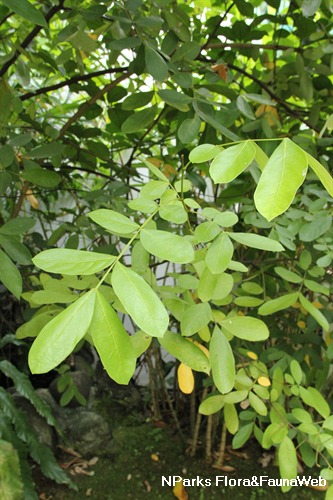
Back
Guioa pleuropteris (Blume) Radlk.
| Family Name: | Sapindaceae |
| Common Name: | Kelentit Nyamuk, Kelentit Nyamuk Laut, Medang Putih, Nyamuk, Pena-Pena, Penyamuk, Pokok Serawan Burung, Sempayan Ular, Senyamuk, Sugi Damar |
Name
Classifications and Characteristics
| Plant Division | Angiosperms (Flowering Seed Plants) (Dicotyledon) |
|---|---|
| Plant Growth Form | Tree (Medium (16m-30m), Shrubby (1m-5m), Small (6m-15m)), Shrub |
| Lifespan (in Singapore) | Perennial |
| Mode of Nutrition | Autotrophic |
| Plant Shape | Irregular |
| Maximum Height | 30 m |
Biogeography
| Native Distribution | Myanmar, Cambodia, Vietnam, Thailand, Sumatra, Peninsular Malaysia, Singapore, Borneo, and the Philippines |
|---|---|
| Native Habitat | Terrestrial (Primary Rainforest, Secondary Rainforest, Coastal Forest, Freshwater Swamp Forest, Riverine), Shoreline (Backshore, Sandy Beach) |
| Preferred Climate Zone | Tropical, Sub-Tropical / Monsoonal |
| Local Conservation Status | Native to Singapore (Least Concern (LC)) |
Description and Ethnobotany
| Growth Form | It is a shrub or tree up to 30 m tall. Its dark brown outer bark with white or grey spots is smooth to grooved. Its leaf rachis is slightly winged. |
|---|---|
| Foliage | Its compound leaves have 2–3 pairs of rather sessile, opposite to alternate leaflets with rather leathery leaf blades, and about 0.9–18.7 by 0.5–8.3 cm. The lower leaflets are egg-shaped whereas the upper ones are elliptic to drop-shaped. The lower surface of the leaf blades is covered with hair and has nipple-like bumps. |
| Flowers | Its flowering shoots are clothed with brown hair and are about 0.5–21.6 cm long. Its flower clusters are usually 2–5 flowered. The fragrant, white flowers are 3–4.2 mm wide. Its 5-merous sepals are green to tinged reddish or whitish, with the three inner sepals larger in size. |
| Fruit | Its red fruits have 1–3 well developed lobes, and are about 1–1.9 by 1–2.5 cm. Its seeds are round to drop-shaped, up to 8 mm wide. |
| Habitat | It grows in primary, secondary and swamp forests or along riverbanks and the sea. It occurs locally in Big Sister Island, North Sister Island, Pulau Tekong, and Pulau Unum. |
| Associated Fauna | Its flowers are insect-pollinated. It is the preferred local food plant of caterpillars of the moth Zeuzera coffeae. Its fruits and seeds are eaten and dispersed by birds. |
| Cultivation | It can be propagated by seed. |
| Etymology | Guioa, commemorating J. Guio, an 18th Century Spanish botanist. Greek pleuropteris, a rib and a wing, possibly referring to the winged rachis |
| Ethnobotanical Uses | Timber & Products: It is a source of timber. |
Landscaping Features
| Landscaping | It is suitable for planting along streetscapes, parks and gardens for its attractive fruits and foliage. |
|---|---|
| Desirable Plant Features | Ornamental Foliage, Ornamental Fruits |
| Landscape Uses | General, Suitable for Roadsides, Parks & Gardens, Small Gardens, Coastal, Beachfront / Shoreline, Riverine, Shade Providing Tree / Palm |
Fauna, Pollination and Dispersal
| Fauna Pollination Dispersal Associated Fauna | Bird-Attracting (Fruits), Butterfly Host Plant (Leaves), Caterpillar Moth Food Plant |
|---|---|
| Pollination Method(s) | Biotic (Fauna) |
| Seed or Spore Dispersal | Biotic (Fauna) |
Plant Care and Propagation
| Light Preference | Full Sun, Semi-Shade |
|---|---|
| Water Preference | Moderate Water |
| Plant Growth Rate | Moderate |
| Rootzone Tolerance | Moist Soils, Well-Drained Soils, Saline Soils / Salt Spray, Fertile Loamy Soils |
| Propagation Method | Seed |
Foliar
| Foliage Retention | Evergreen |
|---|---|
| Mature Foliage Colour(s) | Green |
| Mature Foliage Texture(s) | Leathery |
| Foliar Type | Compound (Even-Pinnate) |
| Foliar Arrangement Along Stem | Alternate, Spiral |
| Foliar Attachment to Stem | Petiolate |
| Foliar Shape(s) | Non-Palm Foliage |
| Foliar Venation | Pinnate / Net |
Floral (Angiosperm)
| Flower & Plant Sexuality | Bisexual Flowers |
| Flower Colour(s) | White |
|---|---|
| Flower Grouping | Cluster / Inflorescence |
| Flower Location | Axillary |
Fruit, Seed and Spore
| Mature Fruit Colour(s) | Red |
|---|---|
| Fruit Classification | Simple Fruit |
| Fruit Type | Fleshy Fruit , Non-Accessory Fruit |
Image Repository
Others
| Master ID | 29930 |
|---|---|
| Species ID | 4239 |
| Flora Disclaimer | The information in this website has been compiled from reliable sources, such as reference works on medicinal plants. It is not a substitute for medical advice or treatment and NParks does not purport to provide any medical advice. Readers should always consult his/her physician before using or consuming a plant for medicinal purposes. |

